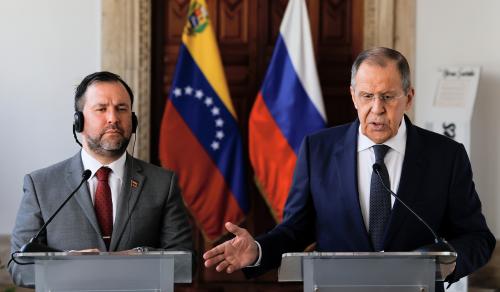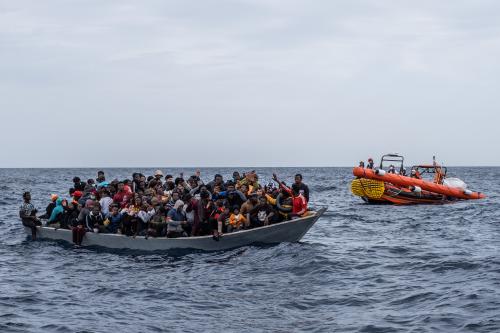The Biden administration should pay particular attention to the Western Hemisphere in setting its foreign policy priorities for the next four years. Central and South America, and Caribbean nations, have long been comparatively sleepy in U.S. foreign policy circles. And while the Trump administration, at times, directed its focus to the region — to Venezuela and Cuba, in particular — there remains significant potential to advance important U.S. strategic interests with but a few relatively low-cost, discreet, tailored actions, that would seemingly align with President-Elect Biden’s foreign policy world view.
Here, I do not purport to present a comprehensive policy for the hemisphere, which must address things like transnational criminal organizations, counter-narcotics policy, and energy and environmental issues. Leaving aside that important discussion for now, there are key signals that the Biden administration can send right out of the gate on democracy issues, economic development and immigration policy, trade, and more.
A premium on democracy
As a first step, the Biden administration should try to bring countries in Central and South America, and the Caribbean, into the aspirational coalition of democracies initiative. Doing so would signal renewed American attention on the institution of democracy with our regional neighbors, many of whom are suffering from a marked decline in democratic norms and ideals. The region’s mixed response to the COVID-19 pandemic has likely exacerbated this decline.
Establishing and jealously protecting relationships between the United States and Latin American democracies would alert the more authoritarian leaders in the region — like in Venezuela, Nicaragua, Cuba, and increasingly Brazil — that this administration will place a premium on its relationship with democratic partners. This should help shape the whole of future regional interactions and transactions.
Improving U.S. policies on economic development and immigration
Next, the administration should pursue new ways, beyond the Alliance for Prosperity and América Crece, for the United States to help enhance economic development in the region.
Improving economic conditions will help check the seemingly constant challenge posed by irregular out-migration, especially as the effects of global climate change continue to exacerbate the risk of such migration. Moreover, economic development could serve as an important counter-balance to China’s Belt and Road Initiative (BRI) and its growing aspirations throughout the region.
While admittedly a bit axiomatic, improving economic conditions — especially in Central and South America, though also in the Caribbean — would address a significant “push” factor for migrants fleeing their respective countries, usually for the United States. This is particularly true of the so-called “Northern Triangle countries” of El Salvador, Guatemala, and Honduras. Irregular migration from these countries — and others in the region, including increasingly Mexico — to the United States appears to indeed be a persistent issue, despite a near singular focus on it from the outgoing Trump administration.
A new Biden administration might see similar numbers of irregular migrants arriving at the U.S. land border as the Trump administration saw in its initial months (and really, throughout its tenure). As a result, it could very well find itself with an all-consuming foreign policy challenge that prevents it from addressing other important issues.
In such a situation, a Biden team would likely face strong pressure from its political left flank to immediately and aggressively unwind — or at a minimum, not apply — Trump-era immigration policies. These policies, not counting the public health measures at the border in response to COVID-19, include of course the wall construction, the Migrant Protection Protocols (MPP), the third-country asylum rule, and the network of Asylum Cooperative Agreements, all of which the outgoing Trump administration used to great effect to deny entry, execute removals, and facilitate the transportation of arriving migrants to other countries. This issue is complicated by U.S. public opinion: A large portion of Americans apparently continue to support at least the ends achieved by such policies, especially during the pandemic, thus creating the condition where rapidly fielding a feasible solution to a fresh surge of migrants at the border may well prove both operationally and politically untenable.
So, as they say, the best defense is a good offense, which makes it critical for a new Biden administration to take the initiative to improve the economic conditions of our regional neighbors. It should do so rapidly, especially as a Biden presidency in and of itself likely creates its own not insignificant immigration “pull” factor. While this initiative may not stop all of the inevitable flow to the U.S. southwest border, clearly articulating this goal may help mitigate the numbers involved.
A better approach to trade
With respect to trade, the Biden administration could start by looking to the United States-Mexico-Canada (USMCA) trade agreement as a model to develop a new network of bilateral or smaller multilateral trade deals in the region. While Mexico and Canada’s relationship with the United States is different in kind than the relationship that the United States has with the other nations in the hemisphere, the USMCA does provide a useful model by which to frame potential future regional trade agreements in that it has the benefit of being approved by the U.S. Congress. Thus, using the USMCA as a model for bilateral or small multilateral trade agreements would seem to have advantages over trying to create additional deals whole cloth or pursuing a more broadly applied regional initiative.
The new Biden administration should also immediately begin work with Congress to amend the Better Utilization of Investments Leading to Development Act (the “Build Act”). The Build Act does several things, but most importantly it merged two legacy agencies — the Overseas Private Investment Corporation (OPIC) and the Development Credit Authority (DCA) — to create the U.S. International Development Finance Corporation (DFC). The DFC helps facilitate U.S. businesses overseas, and to date, it’s provided $8.5 billion in development commitments in Central and South America. Those commitments are the highest per region worldwide, which is a trend that the Biden administration should seek to continue.
The Build Act, however, restricts the DFC’s activities by limiting the types of countries the DFC may coordinate with. It defines “less developed country” as “a country with a low-income economy, lower-middle-income economy, or upper-middle-income economy, as [further] defined by the International Bank for Reconstruction and Development and the International Development Association (collectively referred to as the “World Bank”).” In other words, “less developed country” excludes “high income countries” from its definition.
The act later goes on to require the DFC to “prioritize the provision of support … in less developed countries with a low-income economy or a lower-middle-income economy” and restricts the provision of support to upper-middle-income countries, unless “the President certifies to the appropriate congressional committees that such support furthers the national economic or foreign policy interests of the United States; and such support is designed to produce significant developmental outcomes or provide developmental benefits to the poorest population of that country.”
While that restrictions may make sense on the surface, the practical realities in the Western Hemisphere require more flexibility. For example, Panama, Chile, and Uruguay, and Caribbean countries like the Turks and Caicos, St. Kitts and Nevis, and Trinidad and Tobago are not defined as “less-developed,” but the United States has an interest in helping them develop better emergency and disaster prevention systems, as well as response capabilities and capacity. Many of these nations lack sufficient emergency response infrastructure, and their far-flung geographic locations also tend to increase the difficulty of providing international assistance when needed. Indeed, relatively well-off island nations, even those near the United States, can struggle with emergency and disaster response, as the Bahamas learned after Hurricane Dorian. Amending the Build Act to facilitate assistance so more of our regional neighbors can establish emergency and disaster resilience can mitigate the costs of providing post-event disaster assistance, as well as the risks that an overwhelming disaster drives an outward migration.
Finally, and particularly in light of the COVID-19 pandemic, the Biden administration should look to use the Build Act to facilitate “near-shoring” critical supply chains away from China, to improve regional resilience. Demand for medical supplies and personal protective equipment remains high in the United States and elsewhere. Many communities have exhausted their medical supply stockpiles. And future pandemics akin to COVID-19 are completely foreseeable. Of course, the United States should first look for opportunities to re-onshore medical supply chains. It should also ensure that the players involved have a consistent view of what is actually critical, which was a largely unanticipated, extra challenge during the regional COVID-19 response in the spring. But this type of bio-economic development could also help further stabilize the region by providing jobs producing critical pandemic gear that will likely continue to remain in demand. It also gives U.S. industry an alternative to the low-cost labor provided by China when it makes sense to offshore production capacity, and creates a means to keep economic pressure on China, short of the heavy-handed tariffs favored by the outgoing Trump administration.
Countering China
Finally, the Biden administration should pursue an amendment to establish a broad waiver authority within the Build Act which would allow the president to wield the act’s provisions as a way to provide economic development options so that countries in the hemisphere are not made victim of China’s BRI-based “debt trap diplomacy.” Like elsewhere in the world, China is looking to loop in the nations of the Western Hemisphere to the BRI to extend its trade networks and, perhaps more importantly, its influence. The Build Act is supposed to help counter the BRI, but given the act’s limitations in scope, it just isn’t a fair match-up. If Congress is unwilling to allow for wholesale application of the act to high income countries in the Western Hemisphere, perhaps it would do so if the president, on advice from the relevant cabinet secretaries, made a similar certification as to what the act contemplates for upper-middle income nations. Granting this expanded authority may also be a great way for Congress to “beta test” the concept to see if it there is utility as a check on Chinese BRI-based aspirations elsewhere, while allowing the United States to better couple development opportunities with a strong emphasis on freedoms, rights, and adherence to democratic norms.
Other pieces of the puzzle
These ideas are but a start. Even if the Biden administration were to include measures like these to improve the democratization and economic development of the Western Hemisphere as an important part of its foreign policy strategy, it would still need to contend with the region’s cultural legacy of government corruption and increasingly dangerous transnational criminal organizations, who like the global terrorists of the early 2000s, are demonstrating both the willingness and the capacity to wield great violence and intimidation to challenge the traditionally dominant role of regional state actors. And of course, Venezuela remains an issue, the Trump administration’s “maximum pressure” campaign notwithstanding. But, focusing on economic development in Latin America could be a useful start to the conversation and may provide a path forward in establishing a “new look” U.S. foreign policy posture for the region.
The views expressed are the author’s alone and do not reflect the official policy or position of the United States Coast Guard, U.S. Department of Defense, U.S. Department of Homeland Security, or the U.S. Government










Commentary
Under Biden, the United States should be there for its neighbors in the Western Hemisphere
November 24, 2020